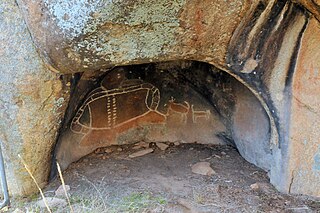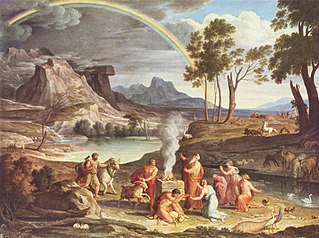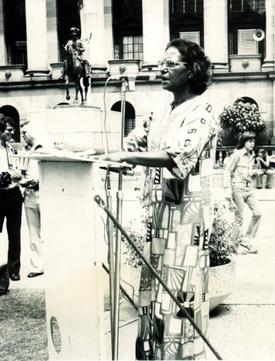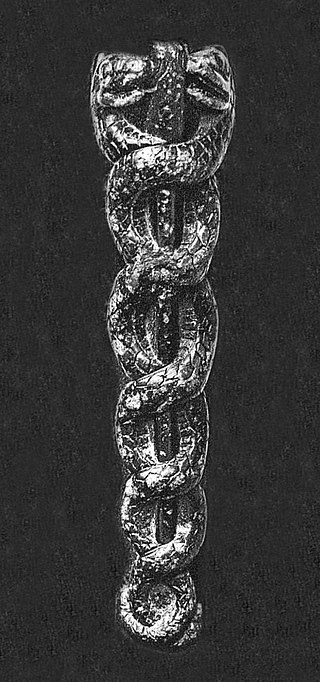
The following is a list of Australian Indigenous Australian deities and spirits.

The following is a list of Australian Indigenous Australian deities and spirits.
The serpent, or snake, is one of the oldest and most widespread mythological symbols. The word is derived from Latin serpens, a crawling animal or snake. Snakes have been associated with some of the oldest rituals known to mankind and represent dual expression of good and evil.
In Karajarri mythology, the Bagadjimbiri are two brothers and creator gods. They arose from the ground as dingos and made water-holes, sex organs for the androgynous first people, and invented circumcision. Taking human form, the Bagadjimbiri began an argument with Ngariman, a quoll-person. Ngariman was annoyed by the Bagadjimbiri's laughter. He killed the brothers underground, but was drowned by Dilga, their mother, who flooded the underground murder-spot with her milk, which also revived her sons. The Bagadjimbiri eventually turned into snakes and went to live in the sky as clouds.

Bunjil, also spelt Bundjil, is a creator deity, culture hero and ancestral being, often depicted as a wedge-tailed eagle in Australian Aboriginal mythology of some of the Aboriginal peoples of Victoria.
The Wawalag sisters, also written as WauwalukWawilakWaggilak, Wagilag, or Wawalik, are ancestral creator beings whose story is part of "the most widespread" sacred rituals in the Aboriginal culture from Arnhem land, Northern Territory, Australia. Their story takes place in Dreamtime, a period of time in Aboriginal belief where ancestral beings created the land as well as the social and linguistic structures in it. The sisters are said to have helped draw linguistic and social differences amongst the clans in Arnhem Land, but the ceremonies associated with their stories create cultural unity.

The rainbow has been a favorite component of mythology throughout history. Rainbows are part of the myths of many cultures around the world. The Norse saw it as Bifrost; Abrahamic traditions see it as a covenant with God not to destroy the world by means of floodwater. Whether as a bridge to the heavens, messenger, archer's bow, or serpent, the rainbow has been pressed into symbolic service for millennia. There is a myriad of beliefs concerning the rainbow. The complex diversity of rainbow myths are far-reaching, as are their inherent similarities.

Oodgeroo Noonuccal ( UUD-gə-roo NOO-nə-kəl; born Kathleen Jean Mary Ruska, later Kath Walker was an Aboriginal Australian political activist, artist and educator, who campaigned for Aboriginal rights. Noonuccal was best known for her poetry, and was the first Aboriginal Australian to publish a book of verse.

The Rainbow Serpent or Rainbow Snake is a common deity often seen as the creator God, known by numerous names in different Australian Aboriginal languages by the many different Aboriginal peoples. It is a common motif in the art and religion of many Aboriginal Australian peoples. Much like the archetypal mother goddess, the Rainbow Serpent creates land and diversity for the Aboriginal people, but when disturbed can bring great chaos.

Snake worship is devotion to serpent deities. The tradition is present in several ancient cultures, particularly in religion and mythology, where snakes were seen as the holders of knowledge, strength, and renewal.

Snakes are a common occurrence in myths for a multitude of cultures. The Hopi people of North America viewed snakes as symbols of healing, transformation, and fertility. In other cultures snakes symbolized the umbilical cord, joining all humans to Mother Earth. The Great Goddess often had snakes as her familiars—sometimes twining around her sacred staff, as in ancient Crete—and they were worshipped as guardians of her mysteries of birth and regeneration. Although not entirely a snake, the plumed serpent, Quetzalcoatl, in Mesoamerican culture, particularly Mayan and Aztec, held a multitude of roles as a deity. He was viewed as a twin entity which embodied that of god and man and equally man and serpent, yet was closely associated with fertility. In ancient Aztec mythology, Quetzalcoatl was the son of the fertility earth goddess, Cihuacoatl, and cloud serpent and hunting god, Maxicoat. His roles took the form of everything from bringer of morning winds and bright daylight for healthy crops, to a sea god capable of bringing on great floods. As shown in the images there are images of the sky serpent with its tail in its mouth, it is believed to be a reverence to the sun, for which Quetzalcoatl was also closely linked.

The sky often has important religious significance. Many religions, both polytheistic and monotheistic, have deities associated with the sky.
Australian Aboriginal culture includes a number of practices and ceremonies centered on a belief in the Dreamtime and other mythology. Reverence and respect for the land and oral traditions are emphasised. Over 300 languages and other groupings have developed a wide range of individual cultures. Due the colonization of Australia under terra nullius concept these cultures were treated as one monoculture. Australian Aboriginal art has existed for thousands of years and ranges from ancient rock art to modern watercolour landscapes. Aboriginal music has developed a number of unique instruments. Contemporary Australian Aboriginal music spans many genres. Aboriginal peoples did not develop a system of writing before colonisation, but there was a huge variety of languages, including sign languages.

A weather god or goddess, also frequently known as a storm god or goddess, is a deity in mythology associated with weather phenomena such as thunder, snow, lightning, rain, wind, storms, tornadoes, and hurricanes. Should they only be in charge of one feature of a storm, they will be called after that attribute, such as a rain god or a lightning/thunder god. This singular attribute might then be emphasized more than the generic, all-encompassing term "storm god", though with thunder/lightning gods, the two terms seem interchangeable. They feature commonly in polytheistic religions, especially in Proto-Indo-European ones.

Barnumbirr, also known as Banumbirr or Morning Star, is a creator-spirit in the Yolngu culture of Arnhem Land in the Northern Territory of Australia, who is identified as the planet Venus. In Yolngu Dreaming mythology, she is believed to have guided the first humans, the Djanggawul sisters, to Australia. After the Djanggawul sisters arrived safely near Yirrkala in North East Arnhem Land, Barnumbirr flew across the land from east to west, creating a songline which named and created the animals, plants, and geographical features.